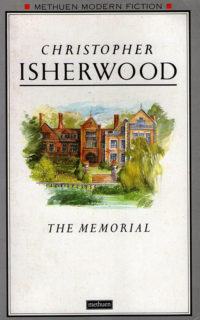Book review: The Memorial by Christopher Isherwood

I forget when I discovered Christopher Isherwood, but of course the first of his books that I read was Goodbye to Berlin and I was hooked. I have been gradually adding more of his books to my library and none of them has yet disappointed.
This is Isherwood’s second novel, published when he was just 28, which is remarkable in hindsight. It depicts a group of family and friends in the aftermath of the First World War, jumping around in time in the 1920s.
The two primary locations are London and a small Cheshire village. Sisters-in-law Lily and Mary do not get on well with each other, but having both lost their husbands in the war, their lives move closer in some ways, as do those of their children.
Each chapter is not only set in a different year, it is told from a different character’s perspective. From the large ensemble cast, we not only get to see through the eyes of Lily and Mary but also Lily’s son Eric, as well as Edward – childhood friend of Lily’s husband.
“Edward didn’t feel the cold. He started forward again, his overcoat flapping loose around him, singing to himself. He was beautifully warm all over, and the thing which kept whizzing round in his head gave him a pleasant sensation of deafness which was in itself a kind of warmth, blunting the edges of the freezing outside world.”
The book opens in London, with a fairly cosy, chatty look at Mary’s bohemian home filled with artistic and activist friends. Equally cosy is Lily getting close to a new gentleman friend, while fretting about her son who has disappointed her in some unnamed way. It’s a shock then to jump to Berlin, where a lonely Edward is struggling with survivor’s guilt and PTSD, contemplating suicide.
This is of course deliberate. Because all the characters are harbouring deep wounds under the apparently idyllic surface of their lives. The world is changing; grief and trauma are widely felt and understood; but eventually people do move on.
“Lily was unpleasantly aware of the nearness of all these people. Of the stuffy smell of their mourning and of their Sunday boots. Their grief, which had seemed beautiful and triumphant over death while they were inside the church, was now, under green trees, crude and hypocritical and sordid. Rooks flapped above them, scattering tiny twigs which fell from high aloft, spinning, to lodge on women’s hats.”
One aspect of this book I found interesting is that Edward is gay, which is hinted at from the start and eventually is said outright, fairly late on in the novel. I was surprised that a book published in 1932 could be even this open, though of course Edward is a deeply unhappy alcoholic so perhaps that made it acceptable (though I don’t think Isherwood added that detail to get past the censors, depression being very understandable if you’re gay in a place and time when that was illegal, not to mention a war veteran). Edward is a mentor of sorts to Eric and one of his cousins, raising the question of whether Eric (or indeed his cousin) is also gay. Perhaps that is the unspoken way in which he has disappointed his mother? I am sure a lot more was said in a coded way that I missed.
It’s a beautiful, melancholic novel. It masterfully evokes a quaint English village, with subtle power plays between the rich families and the vicar.
First published 1932 by the Hogarth Press.
Source: flea market at St Nicks’s, Bristol.
One Comments
Comments are closed.